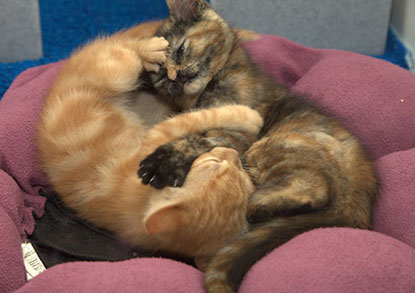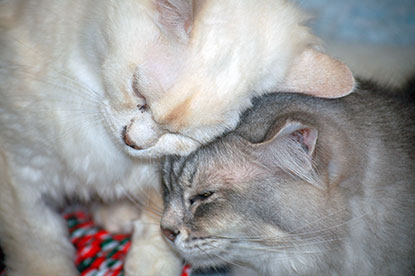Cats
In this week’s behaviour focus post, Cats Protection Behaviour Manager Nicky Trevorrow explains how to recognise feline social groups.
My cats are very close – they’re good friends but every now and then one attacks the other. Why is this?
Firstly it is worth ascertaining whether the cats are fighting or play fighting and whether they were in the same social group to start with. It can be very hard to tell with cats as they have not evolved the complex facial muscles to show a wide variety of facial expressions. Cats struggle with each other too as they don’t have much in the way of appeasement signals to smooth things over.
Signs of cats being the same social group
Signs of cats NOT being in the same social group
It can be hard to identify play fighting, especially in adult cats. Many people think cats are play fighting when in fact they are actually fighting and vice versa. Play fighting is often silent, the claws are sheathed, the cats generally take it in turns and it looks like a bit of a rough and tumble. Compare this now with real fighting whereby the fur is really flying, cats are more likely to vocalise such as hissing, spitting and growling, the claws are out, there may be a lot of posturing beforehand (to try and avoid overt aggressive behaviour) and it may occur in particular ‘hot spots’ of the house where the space is narrow so it is difficult for the cats to avoid each other.
This video shows a cat and kitten play fighting:
If you feel that your cats are fighting one another, then it could be that one or both of the cats have a medical problem. While it is tempting to think that a cat looks fine and doesn't seem in pain, remember that cats are the masters of disguise! Talk about the change in the behaviour of your cats to your vet.
If your vet feels that it is behavioural, then there are a wide variety of possible causes. The key to resolving it is to identify the underlying cause for your specific cats. Getting a referral to a qualified behaviourist, such as the Association of Pet Behaviour Counsellors is the best way and do get it sorted out sooner rather than later. Just wishing the cats would get along, or leaving them to ‘sort it out themselves’ is not going to resolve the problem and it could even get worse if behaviour measures are not put in place. Equally, do not be tempted to tell off the cat that appears to be starting the fights. Things may not be as they seem and again it is likely to make things worse.
Cats are territorial and therefore are not great at sharing. Reduce conflict by providing plenty of resources in different areas of the home. Ideally, the golden rule is one resource per cat plus one extra as a spare.
In each space, provide each cat with the following essential resources:
To learn more about cat social groups, check out our Friends or foes animation video and the Cats Protection leaflet – Cats living together.
- Behaviour Focus: Inappropriate Play
In this week’s behaviour focus post, Cats Protection Behaviour Manager Nicky Trevorrow explains why a cat may show misdirected predatory play behaviour. Why does my cat attack people’s legs when they walk past? If you've read any of my other...
- ‘why Don’t My Cats Get Along?’ And Other Multi-cat Household Faqs
As part of last week’s feline friend or foe campaign, behaviour expert Nicky Trevorrow hosted a very special live Q&A on our national Facebook page. Do you have more than one cat? Are you wondering if they’re friends or foes? Or are you looking...
- Behaviour Focus: Introducing Cats
In this week’s behaviour focus post, Cats Protection Behaviour Manager Nicky Trevorrow explains why two cats may not get along and how to gradually introduce them to one another. I’ve got a new cat. I introduced them to my other cat really slowly...
- Behaviour Focus: Spraying
In this week’s behaviour focus post, Cats Protection Behaviour Manager Nicky Trevorrow explains why cats spray. Why is my cat spraying round the house? Last time I discussed why a cat might urinate or defecate on home furnishings rather than in their...
- Behaviour Focus: Litter Trays
In this week’s behaviour focus post, Cats Protection Behaviour Manager Nicky Trevorrow discusses why cats may not use their litter tray. Why does my cat poo/wee on the furnishings in my house rather than in their litter tray? It’s clean! This is the...
Cats
Behaviour focus: social groups
In this week’s behaviour focus post, Cats Protection Behaviour Manager Nicky Trevorrow explains how to recognise feline social groups.
My cats are very close – they’re good friends but every now and then one attacks the other. Why is this?
Firstly it is worth ascertaining whether the cats are fighting or play fighting and whether they were in the same social group to start with. It can be very hard to tell with cats as they have not evolved the complex facial muscles to show a wide variety of facial expressions. Cats struggle with each other too as they don’t have much in the way of appeasement signals to smooth things over.
Signs of cats being the same social group
- Mutual grooming (known as allogrooming)
- Mutual rubbing (known as allorubbing)
- Sleeping together touching, often with interlocking paws
- Choosing to spend a lot of time in close proximity
- Greeting one another with a tail up, touching noses
- Play fighting with each other
- Communal nursing of young (more commonly seen in related female cats in feral colonies)
 |
| Kittens having a play fight! Photo by Martin Dewhurst |
- Time sharing resources such as a favourite sofa. One cat may use it in the morning and the other cat may use it in the afternoon
- Emotionally blocking access to resources. One cat may look too anxious to approach unless the other cat is not around. Cat flaps and litter trays commonly get blocked by cats
- Living in separate areas of the house. One cat may live predominantly upstairs, while the other mostly lives downstairs
- Recurrent stress related illnesses, such as cystitis, over-grooming and skin conditions
- Behaviour problems like inappropriate toileting, spraying and aggressive behaviour
It can be hard to identify play fighting, especially in adult cats. Many people think cats are play fighting when in fact they are actually fighting and vice versa. Play fighting is often silent, the claws are sheathed, the cats generally take it in turns and it looks like a bit of a rough and tumble. Compare this now with real fighting whereby the fur is really flying, cats are more likely to vocalise such as hissing, spitting and growling, the claws are out, there may be a lot of posturing beforehand (to try and avoid overt aggressive behaviour) and it may occur in particular ‘hot spots’ of the house where the space is narrow so it is difficult for the cats to avoid each other.
This video shows a cat and kitten play fighting:
If you feel that your cats are fighting one another, then it could be that one or both of the cats have a medical problem. While it is tempting to think that a cat looks fine and doesn't seem in pain, remember that cats are the masters of disguise! Talk about the change in the behaviour of your cats to your vet.
If your vet feels that it is behavioural, then there are a wide variety of possible causes. The key to resolving it is to identify the underlying cause for your specific cats. Getting a referral to a qualified behaviourist, such as the Association of Pet Behaviour Counsellors is the best way and do get it sorted out sooner rather than later. Just wishing the cats would get along, or leaving them to ‘sort it out themselves’ is not going to resolve the problem and it could even get worse if behaviour measures are not put in place. Equally, do not be tempted to tell off the cat that appears to be starting the fights. Things may not be as they seem and again it is likely to make things worse.
 |
| These cats are allorubbing or mutual rubbing; photo by Gemma Lovegrove |
In each space, provide each cat with the following essential resources:
- food and water (cats like to drink away from where they eat, so place the food and water bowls in separate areas)
- somewhere to hide, such as a cardboard box on its side or under the bed
- somewhere to get up high to view surrounds in safety (on top of a wardrobe, shelves, window sills, stools) and this creates extra territory
- somewhere to sleep (igloo beds, cardboard box, blankets in elevated places)
- toys
- a scratch post (try placing near to where the cat sleeps as cats often like to stretch and scratch after they wake up)
- litter tray (place this away from food and water)
- multiple entry and exit points so cats can’t block the only cat flap in the house
To learn more about cat social groups, check out our Friends or foes animation video and the Cats Protection leaflet – Cats living together.
- Behaviour Focus: Inappropriate Play
In this week’s behaviour focus post, Cats Protection Behaviour Manager Nicky Trevorrow explains why a cat may show misdirected predatory play behaviour. Why does my cat attack people’s legs when they walk past? If you've read any of my other...
- ‘why Don’t My Cats Get Along?’ And Other Multi-cat Household Faqs
As part of last week’s feline friend or foe campaign, behaviour expert Nicky Trevorrow hosted a very special live Q&A on our national Facebook page. Do you have more than one cat? Are you wondering if they’re friends or foes? Or are you looking...
- Behaviour Focus: Introducing Cats
In this week’s behaviour focus post, Cats Protection Behaviour Manager Nicky Trevorrow explains why two cats may not get along and how to gradually introduce them to one another. I’ve got a new cat. I introduced them to my other cat really slowly...
- Behaviour Focus: Spraying
In this week’s behaviour focus post, Cats Protection Behaviour Manager Nicky Trevorrow explains why cats spray. Why is my cat spraying round the house? Last time I discussed why a cat might urinate or defecate on home furnishings rather than in their...
- Behaviour Focus: Litter Trays
In this week’s behaviour focus post, Cats Protection Behaviour Manager Nicky Trevorrow discusses why cats may not use their litter tray. Why does my cat poo/wee on the furnishings in my house rather than in their litter tray? It’s clean! This is the...
